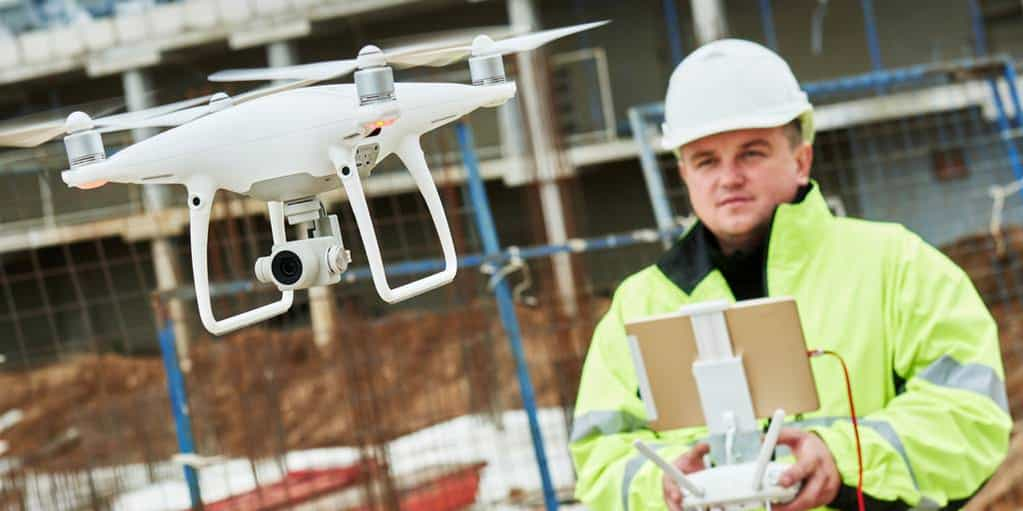Chances are you’ve probably seen them hovering over a construction site, capturing photos and collecting data. Maybe your firm has even used them to do some surveying or to monitor progress on a job. We’re talking about drones, or more correctly unmanned aerial vehicles (UAVs), and construction firms are realizing the many benefits this technology can provide.
UAVs can be equipped with high-speed HD cameras capable of taking stills and video to provide aerial imaging which can then be used to create maps and 3D models of construction sites. LiDAR, laser scanning, and other sensors are also being used to map and model sites. UAVs can operate autonomously using predefined flight paths they can be flown manually using a remote control, some can even be operated using a smartphone or tablet.
Construction firms that are currently using airplane and helicopter services to provide their aerial imagery are going to see huge cost savings by either purchasing and operating their own UAVs or by hiring out the work to a company equipped to provide imaging with UAVs.
UAVs are going to play a significant role in the construction industry. Mapping and surveying of sites, performing building inspections and jobsite safety are all areas that will benefit from the use of UAVs. Video footage taken with UAVs can be used to create 3D images of real-time construction progress. That information can be compared against the architectural plans and construction schedule to accurately monitor the progress of a project. Not only will this help to keep projects on schedule, but it will also be able to determine if construction work is deviating from the design. On excavation and site work projects, UAVs can be used to calculate volumetric measurements to compare how much dirt has been moved each day.
Two areas that UAVs could help improve, worker safety and worker productivity, will probably receive the most pushback from workers over privacy concerns. Construction site are already closely monitored by safety managers, site superintendents and construction managers so this shouldn’t be a major issue. UAVs could cover an entire site in a fraction of the time it would take a person walking and stopping to monitor work and making note of potential safety hazards. Ideally the technology would be used to better protect workers and to identify ways to make workers more productive. UAV’s can be fitted with tablets to enable video-conferencing which could lead to better communication on the jobsite.
UAVs could also be used once everyone has left work for the day. Surveillance UAVs could be deployed to monitor the site for trespassers and would-be thieves. These could be deployed automatically fly along a preprogrammed route to hover above a construction site, possibly eliminating the need for numerous security cameras. Alerts could be immediately sent to owners, GCs and local authorities if unauthorized access is detected.
Research on construction-related applications is being done to determine additional ways UAVs can best serve the industry. A number of construction firms, UAV manufacturers and universities are conducting studies and doing performance tests to see how UAV’s can handle on tasks such as bridge inspections, roof inspections and even performing physical work such as welding.
Companies like Krespy and Precision Drone are making UAV systems for commercial use in industry like agriculture, mining and construction. Phoenix Aerial Systems makes both UAVs and LiDAR mapping systems that can be used in conjunction with each other or separately. Surveying and navigation equipment manufacturers like Topcon and Trimble are also providing UAVs for the construction industry.
Skycatch, a startup out of San Francisco, has worked with construction firms like DPR and Bechtel to develop their UAVs for construction use. The company’s UAVs are being used in conjunction with Komatsu’s Intelligent Machine Control equipped dozers and excavators as part of that company’s SmartConstruction service which provides autonomous site work solutions to customers. AEC software solution firm Autodesk is an investor in Skycatch. Autodesk is partnering with the company to integrate their software to make use of data collected by Skycatch’s UAVs.
If you’d rather outsource your UAV aerial imaging, there are companies that can do the work for you. In addition to providing an experienced operator with a UAV and cameras or other imaging hardware, you have the added benefit of them being fully insured. Companies like Image In Flight, which provided imaging solutions for construction of the new Sacramento Kings arena, and DroneBase have been cleared to operate UAVs commercially. If you’re wanting to try your hand at operating your own UAV, DJI’s Phantom 3 Professional is a great entry-level system that won’t break the bank. For about $1,300 you can get one bundled with everything you need to get started including a 4K camera.
Before you rush out and purchase a UAV for your construction business you should know that operating UAVs for commercial purposes is not currently legal. In order to use one on your next construction project you would need to apply for and be granted an exemption under Section 333 of the Federal Aviation Administration’s (FAA) Modernization and Reform Act of 2012. A recent check of the FAA website shows that over 3,300 exemptions have been granted for commercial use. Over 450 of those exemption cover use by companies on construction sites.
Last February, the FAA issued proposed rules for commercial use of Unmanned Aircraft Systems (UAS), which is the term they use for drones and UAVs. Under the proposed rules the aircraft must weigh less than 55 lbs. and a visual line-of-sight (VLOS) must be maintained without the assistance of any device such as binoculars or onboard cameras. The maximum allowable airspeed would be 100 mph and the maximum altitude for operating the UAV would be 500 feet above ground. Weather conditions would have to allow for three miles of visibility in order to fly a UAV. You can get a rundown of the proposed rules here.
Operators would be required to pass an aeronautical knowledge test and obtain an operator certificate. UAVs would need to be registered and would be required to display identification markings the same as any other aircraft.
Required registration went into effect for all newly purchased UAVs weighing over 0.55 lbs., regardless of whether it’s for recreational or commercial use, starting on December 21, 2015. People who owned and operated UAVs prior to that date have until February 19, 2016 to get registered. Failure to register your UAV can result in civil penalties up to $27,500 and criminal penalties up to $250,000 and/or three years in jail.
Final rules for commercial are expected to be published this year, possibly as early as June. Adoption won’t skyrocket, but once the new rules are in place you can expect to see UAVs showing up at more construction sites. Some construction firms will probably even start placing job advertisements for experienced UAV operators.
Are you ready for the drone revolution? Let us know in comments section below.
About Kendall Jones
Kendall Jones is the Editor in Chief at ConstructConnect. He has been writing about the construction industry for years, covering a wide range of topics from safety and technology to industry news and operating insights.


 Sign In
Sign In


